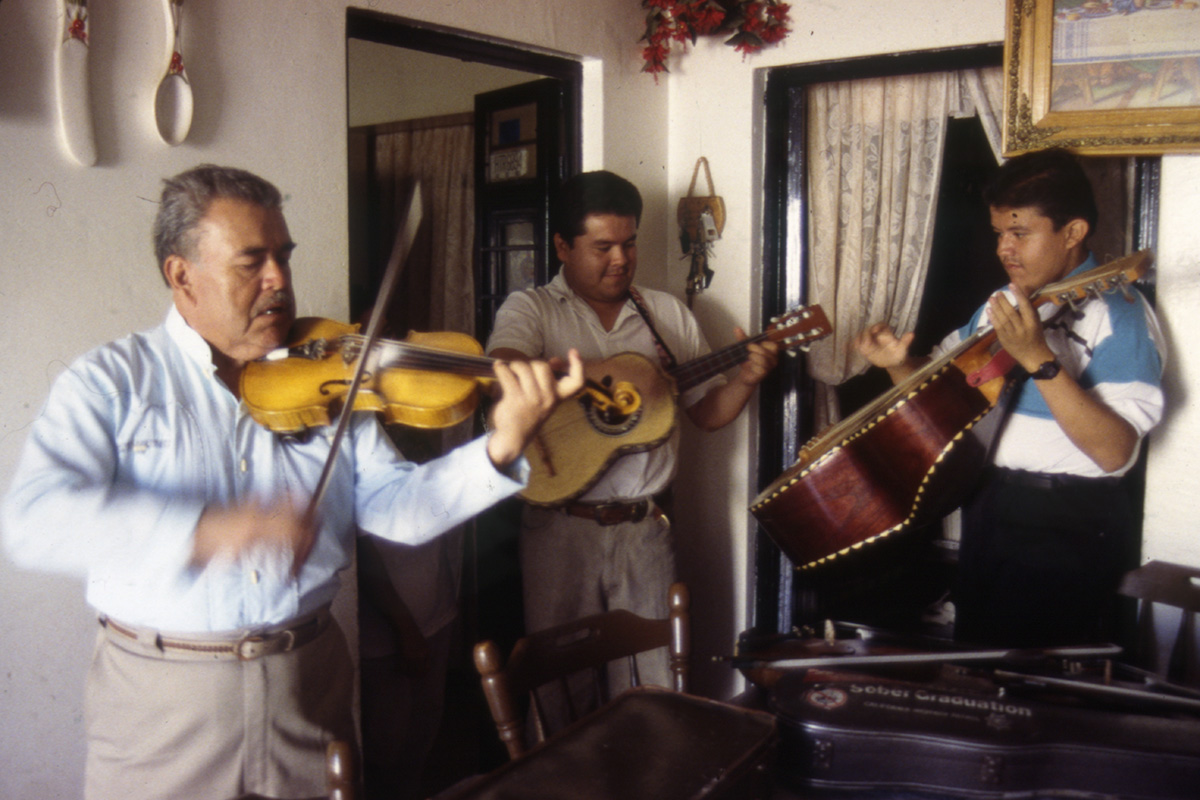I met Santa Claus (the real one!) late one Sunday night in 1974 in La Hacienda Mexican nightclub in downtown Los Angeles. He was a violinist in a mariachi group, and he played for the clubgoers during the dance band’s breaks.
Of course, it wasn’t his real name. In the mariachi world, many musicians are known only by their nickname (apodo, in Spanish), and if you ask for them by their birth names, people won’t know who you are talking about. Santa Claus was recommended to me by a mutual friend who knew I was looking for musicians who were more than musicians, who were the deepest, most complete representatives of the mariachi as a way of life, a culture.
At the time, I was under contract with the Smithsonian, conducting fieldwork for the Smithsonian Folklife Festival. I was to research Southern California’s Mexican community and recommend musicians for the 1976 Festival. It would be a special year for the Festival, marking the United States’ bicentennial of independence. The Festival was planned as a celebration and contemplation of the real-life meaning of e pluribus unum–one nation wrought from many cultures.
It was easy for me to look for musicians. In those days, I was working as a mariachi myself, nearly full time, while studying toward a PhD in ethnomusicology at UCLA. Late at night, after my last gig, I would pack up my trumpet and hit the nightspots. I had recently read an article by ethnomusicologist Robert Garfias, in which he described the Japanese court musicians with whom he worked as artists who were more than did, that is, who thought of their role in life as a state of being more than a state of doing. I understood the purpose of the Festival was to represent ways of life as much as, if not more than, performance, so Garfias’s words were a guide to me.

In Santa Claus, known to his family as Margarito Gutiérrez, I found who I was looking for. He was a third-generation mariachi musician, born in 1942 and raised in the cradle of the mariachi tradition, Ciudad Guzmán in the west Mexican state of Jalisco.
The tradition permeated his life from his youngest years—growing up around musicians, learning from family and musical elders, following the profession to wherever opportunity and adventure took him. He worked stints with groups in Guadalajara and Mexico City but came north to settle in Los Angeles, where he would live most of his life.
Santa Claus was a mariachi through and through. He knew literally thousands of mariachi pieces and was a bearer of mariachi lore in countless ways, including a special talent for telling charras—jokes meant to fill the downtime, many of them very “colorful.”
He also reveled in the origin stories of nicknames. Once someone in the mariachi world gets a nickname, they are stuck with it. He explained that he received his while playing billiards in Tijuana. A mariachi friend walked in and said in jest, probably referring to his round features and light complexion, “What’s up, you **** North American Santa Claus?”
His brothers were mariachi musicians as well, settling near his house in Los Angeles, mere blocks from Mariachi Plaza in Boyle Heights. He married Guillermina “Chata” Alfaro, who estimated that she has a dozen professional mariachis in her extended family in addition to the fifty mariachis in Margarito’s.
Their children—especially César, Rafael, and Claudia—grew up in similar circumstances, surrounded by mariachi musicians, hearing the music every day on the radio and television and in family gatherings, while learning under the strict supervision of their father. When he was eleven, César accompanied his father to hear Mariachi Vargas de Tecalitlán—considered by many to be the “gold standard” of the music. From that moment on, César planned to become a professional mariachi.
His sister Claudia took up the vihuela guitar at the age of nine before switching to violin when she was twelve. She remembers that her father at first discouraged her, telling her that women “didn’t look good” in the mariachi, likely concerned about the challenging life they lived, working long hours in sometimes rough-and-tumble circumstances. But César convinced his dad to change his mind, and he relented, teaching Claudia along with her brothers.
Margarito’s approach was strict and demanding. It was his responsibility to pass on career skills to his children. He was a tough-minded teacher, but all three today appreciate the legacy he and Chata passed onto them. All three went on to perform the music professionally, though Claudia, after playing with the all-female group Rosas Tapatías in Guadalajara, left the musician’s life to dedicate herself to family and her son, Esteban Pérez.
Producer: Daniel Sheehy
Director: Charlie Weber
Story and editing: Gabriela Pérez
Young Esteban took up the music, studying with his grandfather and uncles. When people speak of the family as the main conservatory for traditional music, the Gutiérrez family legacy is precisely what they mean. In the three generations represented here, the notion of the mariachi completo continues, perpetuated by the mariachi tradition’s bedrock of family-based aural learning. This is precisely what UNESCO recognized in 2011 as a “fundamental element of Mexican culture” and a treasure of world humanity.
Margarito Gutiérrez passed away in Los Angeles in 2014. At his wake, nearly seventy mariachi musicians crammed into a modest funeral home in East Los Angeles, playing for hours in tribute to their much-admired friend and colleague. Will his legacy live on? For sure, if Esteban’s attitude is any indicator, as he closes the video with the serious and emphatic words, “¡Que vivan los mariachis!” Long live the mariachis!
May you rest in peace, Santa Claus, and !Que vivan los mariachis!
Daniel “Mister Chicles” Sheehy is director and curator emeritus of Smithsonian Folkways Recordings. He is also a co-founding musician in Mariachi Los Amigos, the longest existing mariachi ensemble in the Washington, D.C., area.


